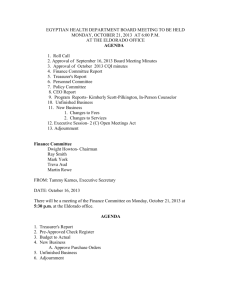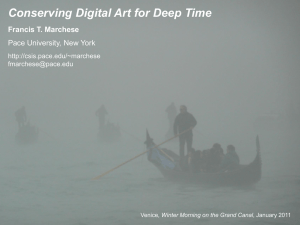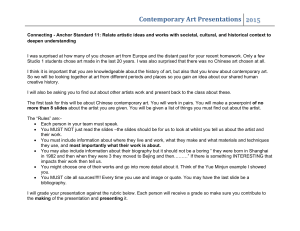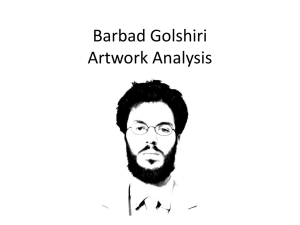Brief encounters: delayed closure as a social art practice
advertisement
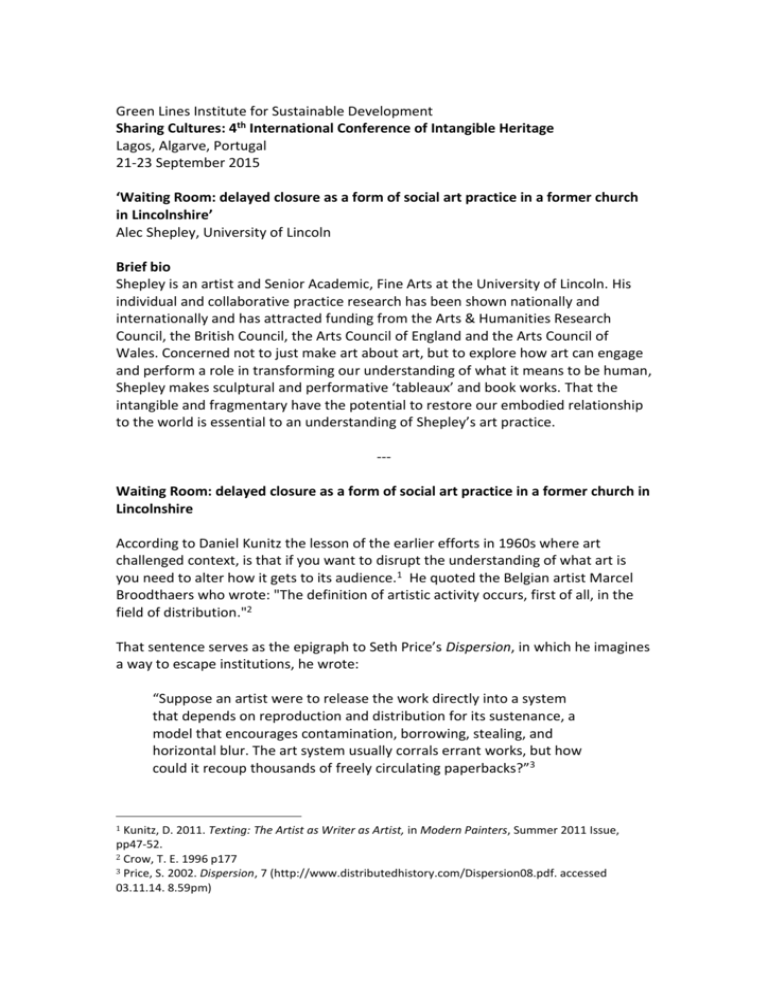
Green Lines Institute for Sustainable Development Sharing Cultures: 4th International Conference of Intangible Heritage Lagos, Algarve, Portugal 21-23 September 2015 ‘Waiting Room: delayed closure as a form of social art practice in a former church in Lincolnshire’ Alec Shepley, University of Lincoln Brief bio Shepley is an artist and Senior Academic, Fine Arts at the University of Lincoln. His individual and collaborative practice research has been shown nationally and internationally and has attracted funding from the Arts & Humanities Research Council, the British Council, the Arts Council of England and the Arts Council of Wales. Concerned not to just make art about art, but to explore how art can engage and perform a role in transforming our understanding of what it means to be human, Shepley makes sculptural and performative ‘tableaux’ and book works. That the intangible and fragmentary have the potential to restore our embodied relationship to the world is essential to an understanding of Shepley’s art practice. --Waiting Room: delayed closure as a form of social art practice in a former church in Lincolnshire According to Daniel Kunitz the lesson of the earlier efforts in 1960s where art challenged context, is that if you want to disrupt the understanding of what art is you need to alter how it gets to its audience.1 He quoted the Belgian artist Marcel Broodthaers who wrote: "The definition of artistic activity occurs, first of all, in the field of distribution."2 That sentence serves as the epigraph to Seth Price’s Dispersion, in which he imagines a way to escape institutions, he wrote: “Suppose an artist were to release the work directly into a system that depends on reproduction and distribution for its sustenance, a model that encourages contamination, borrowing, stealing, and horizontal blur. The art system usually corrals errant works, but how could it recoup thousands of freely circulating paperbacks?”3 1 Kunitz, D. 2011. Texting: The Artist as Writer as Artist, in Modern Painters, Summer 2011 Issue, pp47-52. 2 Crow, T. E. 1996 p177 3 Price, S. 2002. Dispersion, 7 (http://www.distributedhistory.com/Dispersion08.pdf. accessed 03.11.14. 8.59pm) In other words, if you want to free yourself from what some have said are the strangulating forces of the market-driven establishment, then perhaps artists should try unleashing some kind of artistic scheme against the system by flooding it with confusing work. On the other hand art that leaves its place of making is prone to endless manipulation, interpretations and vested interests. 4In bringing the viewer into close proximity of art in its own closest reality I aim to encounter fragmentation and art’s paradoxical inability to render life. In so doing I have discovered disclosing this gap through a kind of purposeful purposelessness can lead to endless possibility.5 This paper contextualizes an iteration of practice enacted in the form of an extended and open-ended residency from spring 2014 to the summer of 2015, in a deconsecrated church in Lincolnshire called x-church. This was a site of neglect and to a large extent is still a work in progress but is also a site which resonates with me as an artist and also chimes well with the theme of this conference in that there are visible traces of an intangible heritage which have marked the building over time. Briefly the people of Gainsborough following a disagreement with the Victorian philanthropist, who originally started the building, completed the church. With funds being limited the building was completed in rather less grand materials and became a symbol of what became known as ‘Slum Gothic’ architecture.6 This in itself is of interest, but in addition the space offered me potential ‘escape route’ from my usual habitat of studio and university. It became a place where I could work in the field of distribution and work with the site and the users, reflecting on various, prescient tropes of reflexivity. These included: Escape options Conscious crumbling Unstructured method Ambivalence Activating Purposeful purposelessness Encounters Anonymity Indeterminate Window shopping (Wanderings/meandering) (Unconscious drifting/getting lost) (No method at all) (Uncertainty/indeterminacy) (New functions of art) (Purposeless purposefulness) (Prompting directional change) (Remain an outsider) (Maintain tortoise-like behaviour) (Merge with the crowd) Acting and thinking through the persistence of art as a system that uncovers spaces of potential through dispersed and uncertain practices, the new works helped me with my broader aim where I am trying to highlight the creative potential of the fragmented, uncertainty and ambivalence and to make art which is perhaps not “of 4 Buren, D. 1970. Beware! in Studio International, Vol. 179, No. 920, March 1970, 100-104 and Kosuth, J. 1977. Comments on the First and Second Frame in Guercio, G. 1991 Art After Philosophy and After: Collected Writings, 1966-90, 169-173. MIT, Cambridge Mass. 5 Hughes, D. 2015 The Lightness of Being in Shepley, A. 2015 Ibid, 7 Sisyphean Projects, 6 http://www.slumgothic.co.uk/index.php?/resident-16-alec-shepley/ 2 art”, outside the usual parameters of art, and to explore a renegotiation with audience – one that includes audience as maker. In my practice as an artist I exploit theatricality and the banal, engage in sweeping and /or cleaning, dérives (often interlinked), as well as photography, text, found and made objects, video, sound, neon, fabric and construction materials often associated with set or stage design or temporary buildings. There is a performative aspect to the work - to open up art as a practice, as a process - as a socially interactive space. “Inasmuch as abstract space [of modernism and capital] tends towards homogeneity, towards the elimination of existing differences or peculiarities, a new space cannot be born (produced) unless it accentuates differences.” 7 In her essay ‘One Place After Another’, Miwon Kwon investigates theoretical and conceptual issues surrounding definitions of art practices associated with site or place and what is at stake in ‘radical positionality’, itinerant artistic practices and resisting the commodification of art - what Erika Suderberg in her introductory essay refers to as a “bending of the structures of exhibition and reception.”8 The ‘bending of structures’ and perhaps more importantly the blurring of boundaries are recognised as important aspects of contemporary art practice and in the practice of learning and teaching within creative arts subjects. It is associated with a shift in the ‘fixity’ of the relationship between artwork, site and audience9, between process, product and commodification/marketisation.10 There has been enormous growth worldwide in exhibitionary infrastructure, artistcurators, curator-artists and engaged spectatorship as responses to contemporary conditions.11 Much of this tendency has found expression as interventions in nongallery spaces and even dilapidated spaces, spaces whose cultural references are fading, becoming less and less tangible. However given the rise of this tendency and the growing interest amongst students and academics to extend practice beyond ‘the place of making’ to investigate sites of modality and audience, there seems to be surprisingly little case study research at this stage by the ‘artist-as-scholar’, to rethink practice in terms of a ‘place’ to re-imagine and to speculate on its creative potential for the ‘student curator’.12 7 Lefebre, H. 1991 The Production of Space (trans. Donald Nicholson-Smith) Oxford: Blackwell Miwon Kwon, M. 2000 One Place After Another: Notes on Site Specificity in Space, Site, Intervention: Situating Installation Art (ed. Erika Suderberg) University of Minnesota Press, pp38-63. 9 Shepley, A. 2008 My Road to Ruin: The Studio Without Walls Sensuous Knowledge 5 Conference on Artistic Research, Bergen National Academy, Norway 10 Onorato, RJ 1997 Blurring the Boundaries: Installation Art 1969-1996 held at the Museum of Contemporary Art, San Diego & Rose, G. 2007 Visual Methodologies: An Introduction to the Interpretation of Visual Materials Sage. 11 Smith, T. 2012 Thinking Contemporary Curating Independent Curators International, New York 12 Shepley, A, 2015 Student As Curator: Exhibition Methodologies Expanded & Reimagined. Symposium presentation on ‘Embedding Partnership in Teaching and Learning’ and the Student As Producer Initiative, 2 July 2015, University of Lincoln 8 3 This project therefore is in response to this perceived gap in the current research base and to provide an opportunity for a creative project in Lincolnshire. Neglected buildings can offer a useful metaphor for our state of being – especially those that offer artists the freedom to explore aspects of practice away from the restrictions of the traditional gallery network. They also offer opportunities to blur boundaries between art object, setting and audience and in addition to this, offer new audiences entirely. What initially attracted me was the porosity of the building. It occurred to me that instead of proposing ‘display works’ within the space and relating them to the user in some way as a site-specific work I would allow something to play out, unfold or happen, perhaps even unnoticed as an actual artwork. Daniel Buren once said that an artwork is closest to its own reality in its place of making and I wanted to bring my studio activities into play within the space, to see what happened when I operated in this zone - as a public encounter instead of a private one. All too often we are being encouraged as artists and academics to perform to a set of criteria that are in many ways alien to the creative process and to learning. They often demand excellence up front - as a pre-requisite - whereas in all research and creativity messy and fail-ridden processes are encountered for the most part. This is part of the journey – the freedom to fail. The idea of starting with no preconceived structure, no plan, is very much a part of my own process and it was refreshing to work in an organization that echoed and indeed supported this sentiment because they know it was fundamental to the learning process. I was very pleased to hear that this was what x-church were expecting me to bring to the space - to occupy the space to respond (or not) to what happened! Adopting an unstructured method of the studio within the space was the most natural way forward and the most obvious way of encountering people in the space. Engaging people in this way – openly or invitationally so to speak – enabled a creative process inclusive of those wishing to ‘play’ but without excluding those who do not wish to partake directly. A level of passivity can be maintained until such time as a more active engagement is sought. From the open-endedness of x-church and the notion of a renewed potential emerging from the near ruins of this place of local heritage, the idea of an open house began germinating at a very early stage in the residency. Findings The question was how to approach this from a place I was not used to occupying – conceptually or physically so I approached it all from the perspective of a work in progress and engaged in a number of activities including the following: 4 The construction of a conversation starter or focal point around making and ad hocism; this became known as x-shed and also the waiting room. The young people frequenting x-church are very dynamic and they enjoy very much the freedom of movement in and around the space, so x-shed was put on wheels and later castors, so it could be moved around the space. It also served as a ‘den’ for the younger ones and later the centrepiece of my final install in July 2015. A digital documentary workshop exploring the physical dilapidation of the building and surrounding area used an app developed especially for the project (this was in collaboration with Dr Duncan Rowland, Reader in Social Computing, University of Lincoln). This resulted in a pop-up exhibition of prints and a movie of all the cracks photographed during the dérive around x-church and Gainsborough. A live drawing event explored simple drawing processes using activities within the building as the subject (this resulted in a piece of sculpture, an ebook; and a hand-bound art book I curated a final group exhibition of nine nationally/internationally recognized artists within x-church, called ‘Waiting Room: the provisionality of the artwork’ The project provided opportunities for this artist to: Engage in creative practice and to engage audience with process art Engage young people from a deprived area and connect them with contemporary art Experience a deepened engagement with the community outside of the campus/studio Curate public events, organise preview events and press releases Commence a taxonomy of potential source material for further practice research Disseminate and contextualise the project within artistic and academic frameworks Gain an enhanced understanding of curating artworks in non-gallery spaces Develop and apply a new framework critical of concepts Evidence contextual knowledge, understanding of reflective practice and collaborative working Work with selected artists from the E Midlands region and to collaborate with them on ideas, engagement and the final exhibition ‘Waiting Room’. Produce an evaluation of the project and its impacts Often an unfinished or incomplete work is regarded with varying degrees of scepticism and even negativity to a certain extent - as if inconclusiveness somehow equates with failure, and the complete connected with success. 5 On the other hand an unfinished object may also be seen as ‘invitational’ e.g. a door not having been given an attractive surface appearance in the final stage of manufacture as the item may be supplied unfinished for you to paint yourself!13 The unfinished work maintains a provisional relationship to its surroundings - to its present. There are many historical examples of works of art, literature, music, film and architecture that have been left unfinished and often the hand of fate has played a key role in this.14 However, an artwork that is unfinished through a deliberate artistic strategy speaks to our condition as humans and preserves an experimental ‘intangible laboratory’ feel that is essential to its interpretation and appreciation.15 The work or object in this condition delays closure – it speaks about what is not there and in so doing conjures a dialogue with what is actually present. The deliberately unfinished work can on the one hand be seen to encourage anticipation, hopes and dreams - a more open, inventive, participatory plurality of voices, and on the other hand unrealised dreams.16 Whichever end of the scale you subscribe to, the unfinished work amounts to a proposition to engage in the work productively - in its potential future(s) - and situates those encountering the work in the present - in what Benjamin calls ‘the time of the now’.17 Rather than focussing [yet again] on failed utopias or abandoned hope this project provides practical examples of current artistic research in the form of the unfinished project as a strategic mode of engagement and renewal.18 The project showcases contemporary art as a social practice that speaks to a ‘lasting and immaculate present’ through the unfinished.19 13 http://www.oxforddictionaries.com/definition/english/unfinished (accessed 02/03/15 12:26) Several works by Da Vinci; literary works by Kafka, Coleridge and Gaskell; Schubert’s No.8 in B Minor; the unfinished works of Orson Welles and Stanley Kubrick; numerous 16 th & 17th century follies; Skipper Tower, New Delhi; 15 Bishop, C. 2004 Antagonism and Relational Aesthetics in October, Fall 2004, No. 110 pp.51-79 MIT 16 Chapman Brothers, Keith Coventry, Conrad Shawcross, Tony Heywood, Gavin Turk, Oliver Marsden, Keith Tyson in Unfinished Symphony, 10 October-10 November 2007, The Fine Art Society, London 17 Benjamin, W. 1969 Illuminations New York: Schocken pp261-263. 18 Bishop, C. 2014 Déjà vu: contemporary art and the ghost of modernity MPavilion, Monash University Museum of Art, (public lecture, 17/12/14, 6.30pm-7.30pm) 19 Habermas, J. 1980 Modernity: an unfinished project in D'Entrèves, MP & Benhabib, S. (Eds) (1997) Habermas and the unfinished project of modernity, MIT Press 14 6
